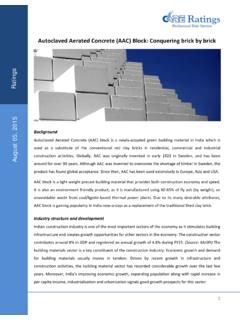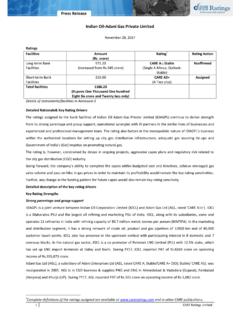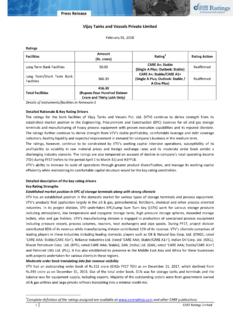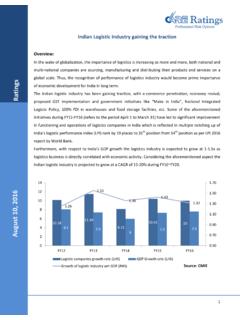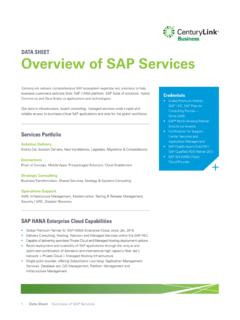Transcription of Impact of proposed GST on Indian Logistics Industry
1 A 1 Impact of proposed GST on Indian Logistics Industry overview of Indian Logistic Industry : The Indian logistic Industry is expected to grow steadily, led by e-commerce penetration, economy revival, proposed GST implementation and government initiatives like Make in India , National Integrated Logistic Policy, 100% FDI in warehouses, food storage facilities, etc. Transportation alone holds 60% share of the logistic Industry and rest 40% is contributed by warehousing, freight forwarding, value-added Logistics , etc. Furthermore, with respect to India s GDP growth the Logistics Industry is expected to grow at as Logistics business is directly correlated with economic activity.
2 Considering the aforementioned aspect, the Indian logistic Industry is projected to grow at CAGR of 15-20% during FY16~FY20. Despite these reasons, the logistic sector in India remains entangled in several complexities which primarily includes higher logistic costs and complex tax structure. The implementation of Goods and Service Tax (GST) bill is expected to trim the logistic costs upto 20% from the current levels, however, the persisting high logistic costs could only be resolved by development of Logistics infrastructure. The Indian logistic sector is primarily categorized into four segments comprising transportation, warehousing, freight forwarding and value-added Logistics .
3 The transportation which contributes maximum to the whole pie of logistic sector comprises various means such as road, rail, air and water. India being emerging country with prime dependency upon transportation through land, through road and rail together which contributes about 60% followed by Warehousing compromising industrial and agricultural storage. Segmentation of India Logistic Industry Ratings July 11, 2016 Ratings Impact of proposed GST on Indian Logistic Industry 2 Current Issues and challenges Despite being a lower cost service providing country, India has higher Logistics cost due to various issues and challenges faced by the Industry .
4 Apart from being entangled in complex tax structure, the Industry is also affected by poor rate of customs efficiency of clearance processes and procedures thus affecting the international export Logistics stratum. Furthermore, sub-optimal comfort provided by the existing Indian infrastructure combined with lack of implementation of efficient IT-enabled tracking and tracing mechanisms has adversely affected the performance of Logistics . The current article delineates upon the complex tax structure issue faced by the logistic Industry and the benefits that this Industry would derive upon implementation of GST, thus providing respite to certain extent to the Industry .
5 Complex tax structure: Currently, each of India s 29 states taxes goods that move across their borders at various rates. As a result, freight that moves across the country is taxed multiple times. How the introduction of Goods and Service Tax (GST) would benefit the Indian logistic Industry ? Goods and service tax is a colligation of multiple taxes levied by both Central ( , excise duty, countervailing duty and service tax) and state (Value-added tax, Octroi and entry tax, luxury tax, etc) governments when an end-user purchases goods or services. It means same level of taxation would be charged on a specific product or service across the entire country irrespective of being manufactured and sold in different states.
6 The planned dual GST model (central GST and state GST) proposes to replace around 29 state and federal taxes and tariffs for a single tax at the point of sale. The current combined Centre and State statutory rate for most goods works out to be (Cenvat of 14%, and VAT of ), whereas post GST implementation the same is expected to reduce to standard rate of about 18-21% which will be levied on most goods and all services. Ratings Impact of proposed GST on Indian Logistic Industry 3 CGST: Central Goods and Service Tax; SGST: State Goods and Service Tax; CVD: Countervailing Duty; SAD: Special Additional duty The following table illustrates the expected benefits that Logistics Industry would derive post implementation of GST: Pre GST Post GST Interstate tax burden Currently, each of India s 29 states taxes goods that move across their borders at different rates apart from that Corporate state tax of 2% is levied for inter-state goods transfer.
7 Not applicable. Uniform taxation and no varying tax structures would be allowed across states. Nature of the Industry Current interstate taxation has resulted in a large number of unorganized players in this Industry . Resulting in fragmented Industry . With the introduction of GST, there is likely to be major consolidation in the Industry . It could see the emergence of major large players who can span the entire Logistics chain. Logistic time Due to trade barriers such as entry taxes, local body taxes, OCTROI and other hurdles, trucks lie idle for 30 to 40% as per Industry estimates during their delivery schedule.
8 Improvement in the logistic time after phasing out the border check posts resulting in improvement in operational efficiency through quicker and increased number of deliveries along with reduction in logistic cost during the transit. As per world bank estimation Indian corporates can save upto 30-40% of logistic costs incurred due to stoppages at various tolls and check posts. Cost The existing interstate taxation system has forced the companies to create and maintain warehouses in each state. Currently, there are around 20-30 warehouses per company, one in every state, in addition to this 20-30 Carry & Forwarding agents per state making the supply chain longer and inefficient.
9 GST tax will be levied on transportation of goods and full credit will be available on interstate transactions. Logistic costs are expected to be decreased by of sales on account of optimization of warehouses leading to lower inventory costs which are set up across states to avoid paying 2% corporate sales tax and phasing out of interstate sales tax. There is immense scope for optimization of costs. The rollout of GST, in India would dissolve the existing indirect tax structure, ie, multiple taxes that is being split between center and state governments leading to reduction of about 20% of current logistic costs.
10 Ratings Impact of proposed GST on Indian Logistic Industry 4 Impact of GST on Third party Logistic service providers (3PL): Post GST implementation the 3PL s would have to restructure its assets and realign its operations in line with changes in the operations of its customers in the new scenario. Currently, 3PL s have warehouses located near major distribution centers of its key clients (different industries) irrespective of its geographic disadvantage mainly to avoid interstate taxes. However, post GST implementation 3PL s are expected to build integrated warehouses at logistic suitable locations.



